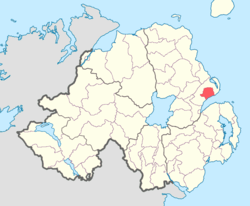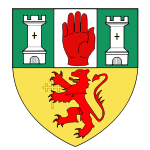Carrickfergus (barony)
Carrickfergus is a barony in County Antrim, Northern Ireland.[2][3] It is bounded on the south-east by Belfast Lough, and otherwise surrounded by the barony of Belfast Lower.[2][3] It is coextensive with the civil parish of Carrickfergus or St Nicholas[4][5][6][7] and corresponds to the former county of the town of Carrickfergus, a county corporate encompassing Carrickfergus town.[8]
Carrickfergus Carraig Fhearghais[1] (Irish) | |
|---|---|
 Location of the barony of Carrickfergus, County Antrim, Northern Ireland. | |
| Sovereign state | United Kingdom |
| Country | Northern Ireland |
| County | Antrim |
History
Carrickfergus Castle was the stronghold of the Earl of Ulster in the Anglo-Norman period, and Carrickfergus or Knockfergus was one of the medieval counties into which the Earldom was divided. After the Tudor reconquest of Ireland, the east coast of Ulster was rationalised into counties Antrim and Down, but Carrickfergus retained its ancient status as a separate corporate county. Whereas most such counties comprised an urban municipal borough and surrounding rural liberties, the royal charter of James I made the borough of Carrickfergus coterminous with the county of the town. The Municipal Corporations (Ireland) Act 1840 formally abolished the borough, and replaced its corporation with town commissioners.[8] The grand jury of the county of the town of Carrickfergus was unchanged by the 1840 act.[7] Till 1850, Carrickfergus was also county town of Antrim; the Town Gaol and Town Courthouse were for the county of the town, while the County Gaol and County Courthouse were separate buildings within the town regarded as exclaves of county Antrim, but from 1800 both counties used the same facilities.[9][10] The parliamentary borough of Carrickfergus was coterminous with the county of the town from the Act 2 & 3 William IV c.89[11][12][13] till it was abolished under the Redistribution of Seats Act 1885.
In 1899, under the terms of the Local Government (Ireland) Act 1898, the Local Government Board for Ireland combined the judicial county of the town of Carrickfergus and most of the judicial county of Antrim into the administrative county of Antrim. Thereafter the area was sometimes but not always considered as a barony. In the topographical index of the 1926 census, Carrickfergus is not in the list of baronies,[14] and the "barony" value listed for the corresponding townlands is blank.[15] However, notices in The Belfast Gazette from the same era refer to the "barony of Carrickfergus",[16] and it is listed on the Public Record Office of Northern Ireland website.[2]
The area subject to the town commissioners of Carrickfergus became an urban district; the rest of the county of the town became the Carrickfergus Rural district electoral division (DED) of Larne rural district. Eden DED was split out of Carrickfergus Rural DED from 1908.[17][18] Since the Local Government Act (Northern Ireland) 1972 the whole barony forms part of the jurisdiction of Carrickfergus Borough Council.
Settlements
Below is a list of settlements in Carrickfergus:[1][19]
Towns
Villages
Population centres
- Eden
- Mile Bush
- Woodburn
Civil parishes
Carrickfergus or St Nicholas is the only civil parish in the barony and has 5 townlands.[20]
Townlands
The county of the town of Carrickfergus in 1891 comprised five townlands: Carrickfergus (comprising the historic town, and most of the later urban district); Commons, Middle Division, and North East Division (in DED of Eden), and West Division (DED of Carrickfergus Rural; at 6732 acres, the largest townland in Northern Ireland).[17][21] There was uncertainty as to whether the townlands of Ballymena Little and Straidland formed part of Carrickfergus; an 1810 courtcase decided they belonged to the Corporation but were not part of the county of the town.[13][22][23] The parish boundaries were also uncertain;[22] the Public Record Office of Northern Ireland website lists four townlands in the parish of "Carrickfergus or St. Nicholas'", namely Carrickfergus, Commons, Green Island, and West Division. [24]
Railway
On the Belfast–Larne railway line, stations in Carrickfergus barony are Greenisland, Trooperslane, Clipperstown, Carrickfergus, and Downshire.
References
- "County of the Town of Carrickfergus". Municipal Corporations (Ireland) Appendix, part II. Reports from Commissioners. 8. HMSO. 1835. pp. 741–787. Retrieved 8 February 2012.
- Topographical Index. Census of Northern Ireland, 1926. Belfast: HMSO. 1929.
- "Carrickfergus". Placenames Database of Ireland. Department of Community, Rural and Gaeltacht Affairs. Retrieved 5 February 2011.
- PRONI Baronies of Northern Ireland
- "Baronies and parishes of County Antrim". Archived from the original on 27 July 2011. Retrieved 5 February 2011.
- Commissioners 1835, §5
- Lewis, Samuel (1837). "Carrickfergus Parish in the 1830s". A Topographical Dictionary of Ireland. Retrieved 8 February 2012.
- "PRONI Civil Parishes of County Antrim". Archived from the original on 27 July 2011. Retrieved 26 June 2010.
- "Carrickfergus". The Parliamentary gazetteer of Ireland: adapted to the new poor-law, franchise, municipal and ecclesiastical arrangements, and compiled with a special reference to the lines of railroad and canal communication, as existing in 1814–45. III. A. Fullarton and co. 1846. pp. 324–5.
- "Carrickfergus". Municipal Boundaries Commission (Ireland): part III: report; minutes of evidence (PDF). Command papers. Cmd.3089. 1881. pp. 254–5.
- Commissioners 1835, §97
- Lewis, Samuel (1837). "Carrickfergus Corporation in the 1830s". A Topographical Dictionary of Ireland. Retrieved 8 February 2012.
- "An Act to settle and describe the Limits of Cities Towns and Boroughs in Ireland in so far as respects the Election of Members to serve in Parliament". The law journal for the year 1832–1949. Abridgment of statutes. X. E. B. Ince. 1832.
- Lewis, Samuel (1837). "Appendix". A Topographical Dictionary of Ireland. II.
- "Carrickfergus". Municipal Corporations Boundaries (Ireland). Reports from Commissioners. XXIX. 10 May 1837. pp. 30–32.
- "List of Baronies": Topographical Index, p.vii
- e.g. "Carrickfergus": Topographical Index, p.51
- e.g. No.360 p.460 (18 May 1928); No.483 p.1118 and p.1125 (26 Sep 1930); No.543 p.1201 (20 Nov 1931)
- Local Government Board for Ireland (1907). "No. 2,181 and No. 11,864.". 35th annual report. Command papers. Cmd.3682.
- "North-east sheet". Boundaries of Administrative Counties, Co. Boroughs, Urban & Dispensary Districts & District Electoral Divisions. Ordnance Survey Ireland. 1961 [1935]. Archived from the original on 5 February 2011. Retrieved 8 February 2012.
- Lewis, Samuel (1837). "Carrickfergus County in the 1830s". A Topographical Dictionary of Ireland. Retrieved 8 February 2012.
- "Carrickfergus". IreAtlas Townlands Database. Retrieved 20 April 2015.
- "Antrim". Census of Ireland 1891: Area, Population and Number of Houses; Occupations, Religion and Education volume III, Province of Ulster. Command Papers. C.6626-IX. Thom's. 1892. pp. 54, Table VII.
- Commissioners 1835, §§4,5
- Lewis, Samuel (1837). "Carrickfergus Government in the 1830s". A Topographical Dictionary of Ireland. Retrieved 8 February 2012.
- "Parish of Carrickfergus or St. Nicholas'". Parishes in Northern Ireland. Public Record Office of Northern Ireland. Archived from the original on 29 August 2011. Retrieved 8 February 2012.
